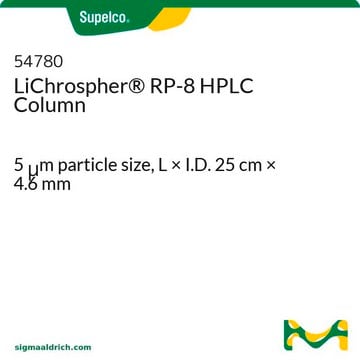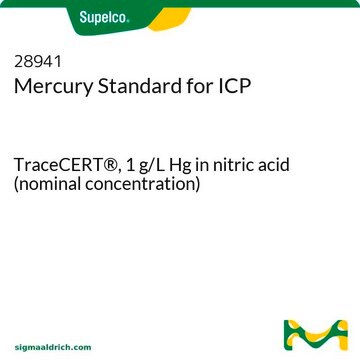While operating pressures may not exceed the 400 bar (6,000 psi) capability of your traditional instruments, sustained pressures of about 200 bar (3,000 psi) will exceed the recommended pressure for conventional PEEK tubing and fittings at the column inlet. We recommend changing to stainless steel fittings in all high pressure locations and have designed special High Performance HPLC Fittings/Interconnects that will stay tight at pressures of 1,000 bar (15,000 psi) or greater, even when elevated column temperatures are employed.
推薦產品
產品名稱
Ascentis ® Express C8,2.7μm HPLC 色谱柱, 2.7 μm particle size, L × I.D. 7.5 cm × 4.6 mm
材料
stainless steel column
品質等級
agency
suitable for USP L7
產品線
Ascentis®
特點
endcapped
製造商/商標名
Ascentis®
包裝
1 ea of
參數
60 °C temp. range
600 bar max. pressure (9000 psi)
技術
HPLC: suitable
LC/MS: suitable
UHPLC-MS: suitable
UHPLC: suitable
長度 × 內徑
7.5 cm × 4.6 mm
表面積
135 m2/g
雜質
<5 ppm metals
基質
Fused-Core particle platform
superficially porous particle
基質活性組
C8 (octyl) phase
粒徑
2.7 μm
孔徑
90 Å
工作pH值範圍
2-9
應用
food and beverages
分離技術
reversed phase
尋找類似的產品? 前往 產品比較指南
一般說明
访问 Ascentis Express 主页,以获得有关此新色谱柱技术的更多信息。
應用
- Recent trends in ultra-fast HPLC: new generation superficially porous silica columns.:综述高效液相色谱(HPLC)表面多孔硅胶柱的发展和性能,包括类似Ascentis Express(C8, 2.7 μm)的色谱柱。体现先进技术对分析速度和效率的影响(Ali et al., 2012)。
- Development and validation of an HPLC-MS/MS method to determine clopidogrel in human plasma.Use of incurred samples to test back-conversion.:使用Ascentis Expresss(C8, 2.7 μm)等色谱柱开发HPLC-MS/MS分析方法以定量血浆中的氯吡格雷。说明柱子可用于临床药动学评估(Silvestro et al., 2010)。
法律資訊
相關產品
防護柱套
儲存類別代碼
11 - Combustible Solids
水污染物質分類(WGK)
WGK 3
閃點(°F)
Not applicable
閃點(°C)
Not applicable
從最近期的版本中選擇一個:
分析證明 (COA)
文章
When a C18 doesn′t give the desired separation, or your sample contains compounds that are known to be difficult to retain or resolve on a C18, consider changing to an Ascentis® Express C8 column.
-
Do I need special fittings and tubing to connect Ascentis® Express HPLC Columns?
1 answer-
Helpful?
-
-
What flow rate should I use with Ascentis® Express HPLC Columns?
1 answer-
Based on the minimum in the van Deemter curves, higher flows than 5um particle columns are required in order to maximize Ascentis Express column efficiency. The suggested starting point for flow rate for Ascentis Express columns: 1.6 mL/min for 4.6 mm ID; 0.8 mL/min for 3.0 mm ID; and 0.4mL/min for 2.1 mm ID.
Helpful?
-
-
Can I use Ascentis Express on a UHPLC system?
1 answer-
Yes. Ascentis Express columns are packed in a way making them suitable for these ultra high pressure instruments. In fact, Ascentis Express outperforms sub-2 μm micron columns on many applications since Ascentis Express provides the benefits of sub-2 μm particles but at much lower back pressure. These benefits include the capability of providing fast HPLC and higher resolution chromatography. The Fused-Core particle consists of a 1.7 μm solid core and a 0.5 μm porous shell. A major benefit of the Fused-Core particle is the small diffusion path (0.5 μm) compared to conventional fully porous particles. The shorter diffusion path reduces axial dispersion of solutes and minimizes peak broadening.
Helpful?
-
-
What is the Department of Transportation shipping information for this product?
1 answer-
Transportation information can be found in Section 14 of the product's (M)SDS.To access the shipping information for this material, use the link on the product detail page for the product.
Helpful?
-
-
Can Ascentis® Express HPLC Columns be used for LC-MS?
1 answer-
Express Fused-Core™ particles were designed with LC-MS in mind. Even extremely short column lengths exhibit sufficient plate counts to show high resolving power. The flat van Deemter plots permit resolution to be maintained at very high flow rates to maximize sample throughput. All Ascentis stationary phases have been evaluated for MS compatibility during their development, and the Express phases are no exception. You can expect extremely low column bleed and background while maintaining longest possible column lifetime. A bonus of Ascentis Express columns for high throughput UHPLC and LC-MS is that they are extremely rugged and highly resistant to plugging, a very common failure mode for competitor columns.
Helpful?
-
-
Can I use Ascentis Express on any type of HPLC system?
1 answer-
Ascentis Express HPLC columns are capable of use on standard HPLC systems as well as UHPLC systems. Columns are packed in high pressure hardware capable of withstanding the pressures used in UHPLC systems.
Helpful?
-
-
How can I measure my instrument bandwidth (IBW) and determine what Ascentis® Express HPLC Columns can be used with minimal efficiency loss created by too much internal instrument volume?
1 answer-
The Guide to Dispersion Measurement has simple instructions on how to measure IBW and can be found at sigma-aldrich.com/express.
Helpful?
-
-
Is there anything special I need to do to my HPLC system to use Ascentis Express?
1 answer-
Nothing special is required to use Ascentis Express HPLC columns. To obtain the full benefits of Ascentis Express, one should minimize dispersion in the HPLC system (tubing, detector flow cell) as well as confirm the detector response system is set at a fast level. For more information, request Guidelines for Optimizing Systems for Ascentis Express Columns (T407102).
Helpful?
-
Active Filters
我們的科學家團隊在所有研究領域都有豐富的經驗,包括生命科學、材料科學、化學合成、色譜、分析等.
聯絡技術服務







